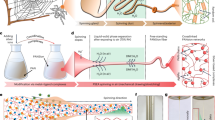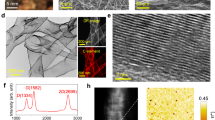These extraordinary composite fibres can be woven into electronic textiles.
Abstract
The energy needed to rupture a fibre (its toughness) is five times higher for spider silk than for the same mass of steel wire, which has inspired efforts to produce spider silk commercially1,2,3. Here we spin 100-metre-long carbon-nanotube composite fibres that are tougher than any natural or synthetic organic fibre described so far, and use these to make fibre supercapacitors that are suitable for weaving into textiles.
Similar content being viewed by others
Main
We used a type of coagulation-based carbon-nanotube spinning method to prepare these fibres. In the original process4, surfactant-dispersed, single-walled nanotubes (SWNTs) were injected into a rotating bath of aqueous polyvinyl alcohol to produce nanotube gel fibres, which were then washed to desorb the polyvinyl alcohol and surfactant5,6. These fragile gel fibres were pulled from the coagulation bath at a rate of about 1 cm min−1 in order to form solid nanotube fibres of some tens of centimetres in length6.
By modifying this method, we were able to spin a reel of nanotube gel fibre and then convert it into 100-m lengths of solid nanotube composite fibre in a continuous process, at a rate of more than 70 cm min−1. The spinning solution is injected into the centre of a cylindrical pipe in which the polyvinyl alcohol coagulation solution flows; contact with the coagulant collapses the spinning solution into a nanotube fibre associated with polyvinyl alcohol, which moves down the pipe for winding on a mandrel.
By using SWNTs synthesized from carbon monoxide7 and lithium dodecyl sulphate as a surfactant, and by optimizing the flow rates of the spinning and coagulation solutions without removing polyvinyl alcohol from the gel, we are able to generate gel fibres that are mechanically strong enough for the second stage of the spinning process. This stage involves unwinding the fibres onto a series of godets that carry them through an acetone-washing bath and then through a drying path so that they can be wrapped onto a mandrel.
The resulting composite fibres are about 50 µm in diameter and contain around 60% SWNTs by weight. They have a tensile strength of 1.8 gigapascals (GPa), which matches that of spider silk2 (see supplementary information). This is seven times greater than the tensile strength of previously reported coagulation-spun nanotube fibres5 and more than 104 times higher than that of 'dry-spun' carbon-nanotube fibres8. Our pre-drawn fibres match the energy absorption of spider silk up to the breaking strain of the toughest silk (30%), and continue absorbing energy until reaching an energy-to-break (570 J g−1) that is higher than that of spider dragline silk (165 J g−1; ref. 2, and see supplementary information), Kevlar fibre (33 J g−1; ref. 2) and graphite fibre (12 J g−1; ref. 9), and of previously described coagulation-spun nanotube fibres (1.7 J g−1; ref. 5). This toughness results from a combination of high strength and high strain to failure (Fig. 1).
Comparison of the strength and failure strain for carbon-nanotube composite fibres for different degrees of initial pre-draw (red line) and the 3,000 materials of all types (lavender field) in the Cambridge Materials Selector database (http://www.grantadesign.com).
Although, at 80 GPa, the Young's modulus of our nanotube composite fibres near failure strain is almost an order of magnitude less than that of high-performance graphite fibres or of individual SWNTs10,11, it is double that of previously described coagulation-spun SWNT fibres5 and equal to that of directly synthesized 20-cm SWNT strands12, which have a strength of about 1.2 GPa and low toughness. Normalized for density, the Young's modulus and tensile strength of our fibres are more than twice the corresponding values for steel wire3, and our fibres are around 20 times as tough. This combination of high strength and high strain at break is not found for other reported nanotube composites13.
The elongation required for toughness is realized because of the absence of measurable fibre necking during deformation. This stability suggests that the strain rate should be roughly linearly dependent on the applied stress (newtonian flow), which we confirmed by stress–strain measurements (see supplementary information). Scanning electron micrographs reveal that the largely amorphous polyvinyl alcohol forms a coating on the nanotubes (results not shown), providing an important interphase region. The toughness of spider silk arises from chain extension in amorphous regions between relatively rigid crystalline protein blocks1, and amorphous polyvinyl alcohol between SWNTs may serve a similar function in our composite fibres. Slippage between individual nanotubes within bundles might also contribute to toughness.
We used our spun nanotube fibres to make supercapacitors and wove them into textiles (Fig. 2). Promising electronic-textile applications for these fibres, which are easy to weave and sew, include distributed sensors, electronic interconnects, electromagnetic shields, antennas and batteries.
Two nanotube composite fibres were separately coated with electrolyte by dipping in aqueous polyvinyl alcohol/phosphoric acid (19% phosphoric acid and 4% polyvinyl alcohol by weight), twisted together and then recoated with electrolyte. This fibre supercapacitor (diameter, 100 µm) provides a capacitance (5 F g−1) and energy-storage density (0.6 W h kg−1 at 1 V) that are comparable to those of large commercial supercapacitors; performance was unchanged over the measured 1,200 charge–discharge cycles. The helically wound nanotube fibres are separated at the capacitor ends so that electrical connections can be made. Scale bar, 1 cm.
References
Kubik, S. Angew. Chem. Int. Edn 41, 2721–2723 (2002).
Vollrath, F. & Knight, D. P. Nature 410, 541–548 (2001).
Lesuer, D. R. et al. Metallurg. Mater. Trans. A 30, 1559–1568 (1999).
Vigolo, B. et al. Science 290, 1331–1334 (2000).
Vigolo, B., Poulin, P., Lucas, M., Luanois, P. & Bernier, P. Appl. Phys. Lett. 81, 1210–1212 (2002).
Poulin, P., Vigolo, B. & Launois, P. Carbon 40, 1741–1749 (2002).
Nikolaev, P. et al. Chem. Phys. Lett. 313, 91–97 (1999).
Jiang, K., Li, Q. & Fan, S. Nature 419, 801 (2002).
Chand, S. J. Mater. Sci. 35, 1303–1313 (2000).
Walters, D. A. et al. Appl. Phys. Lett. 74, 3803–3805 (1999).
Yu, M.-F, Files, B. S., Arepalli, S. & Ruoff, R. S. Phys. Rev. Lett. 84, 5552–5555 (2000).
Zhu, H. W. et al. Science 296, 884–886 (2002).
Mamedov, A. A. et al. Nature Mater. 1, 190–194 (2002).
Author information
Authors and Affiliations
Corresponding author
Ethics declarations
Competing interests
The authors declare no competing financial interests.
Supplementary information
Rights and permissions
About this article
Cite this article
Dalton, A., Collins, S., Muñoz, E. et al. Super-tough carbon-nanotube fibres. Nature 423, 703 (2003). https://doi.org/10.1038/423703a
Issue Date:
DOI: https://doi.org/10.1038/423703a
This article is cited by
-
Effects of Functionalized Multi-walled Carbon Nanotubes on the Performance of Wood–Plastic Composites
Fibers and Polymers (2024)
-
A Review of Multifunctional Nanocomposite Fibers: Design, Preparation and Applications
Advanced Fiber Materials (2024)
-
Multiscale Theories and Applications: From Microstructure Design to Macroscopic Assessment for Carbon Nanotubes Networks
Chinese Journal of Mechanical Engineering (2023)
-
Hierarchically structured bioinspired nanocomposites
Nature Materials (2023)
-
Effect of SiO2-MWCNTs on Mechanical and Tribological Properties of Acrylic Silicone Resin Coating
Journal of Inorganic and Organometallic Polymers and Materials (2023)
Comments
By submitting a comment you agree to abide by our Terms and Community Guidelines. If you find something abusive or that does not comply with our terms or guidelines please flag it as inappropriate.





